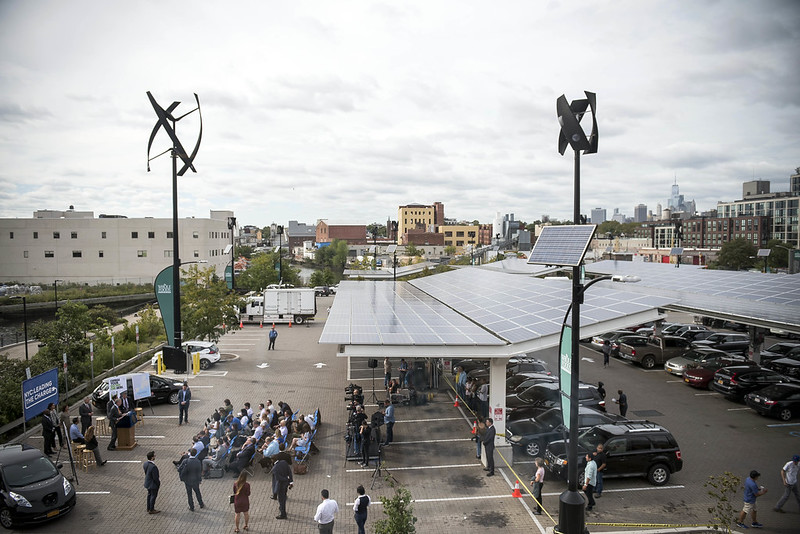
Is the post-coronavirus future renewable? (photo: Ed Reed/Mayor's Office)
There have been many hard-learned lessons from COVID-19, but by far the most tragic – paid for with the lives of tens of thousands of people – is that when it comes to dealing with a public health crisis, preparation and proactive planning is the only approach that can keep our worst nightmares from becoming a reality. While New York is still far from reaching the light at the end of the tunnel, many inside and outside of government have rightly begun to envision what a restart to our economy should look like.
It is in this conversation that we have a unique opportunity to get the restart right by appropriately investing in a cleaner, greener, and more energy-resilient economy that will have the dual benefit of driving much-needed job and economic growth statewide while also helping fortify our defense against the next impending crisis for which there can be no vaccine – that of climate change and its impacts. By ensuring that governments like New York State make our long-term climate change goals a priority as part of the economy-wide restart, we can meet our immediate economic and public health concerns, as well as better position our renewable and clean energy industry to reach our broader climate change goals.
While the public health concerns and dangers of coronavirus are very serious and science should be the determining guide for any economic recovery plans, we shouldn’t lose sight of the climate crisis and how these goals are inextricably linked. New York residents are clearly being harmed by a changing climate caused by carbon emissions, with unequal impacts on the state’s most vulnerable and disadvantaged communities. By starting anew with a clean energy economy, we can expect to greatly reduce the risk of the increasingly serious effects of climate change.
The evidence of New York’s changing climate are readily apparent across every region of the state: a 74% increase in extreme precipitation since the 1950s; an increase in extreme storms like superstorm Sandy, which cost $40 billion in reconstruction and tourism losses; extreme drought in the Finger Lakes; flooding along Lake Ontario’s shoreline; and overwintering pests destroying our forests and crops. Sea level rise is also impairing coastal communities and infrastructure such as airports and sewage treatment plants. Flooding disrupts communities, agriculture, and water quality. New York State’s temperature has increased 2.6 degrees Fahrenheit since 1897. Action is clearly warranted.
Unfortunately, the federal government has abdicated its responsibility to protect the environment; a recent New York Times analysis found that of more than 90 environmental rules and regulations rolled back under the Trump Administration during the last three years, 16 concerned air pollution and emissions.
Without sufficient action at the national level to enact any kind of impact solution to climate change, like a national carbon fee and dividend, it’s up to each state to implement clean energy policies. Governor Cuomo has thoughtfully proposed a gradual approach to reopening the economy, with lower risk activities beginning before others and the private sector doing its part by adjusting to minimize the risk of spreading the coronavirus. That same logic – with New York seeking to implement its own plan irrespective of federal inaction – can and should be applied to investing in carbon-free policies that can help restart our “clean” economy in a safe manner while also advancing climate crisis goals.
New York has always been a national leader in fighting the climate crisis. Last summer, the state enacted the Climate Leadership and Community Protection Act, a historic climate law that calls for 70 percent of the state’s electricity to come from renewable energy by 2030 and 100 percent of the state’s electricity supply to be emissions-free by 2040.
In an effort to reach those goals, the New York Independent System Operator (NYISO) has proposed a carbon-pricing plan. Nearly all leading economists agree that carbon pricing -- which puts a price on carbon emissions to disincentivize such pollution and fund clean energy projects -- is the most efficient single step we can take to significantly reduce greenhouse gas emissions. Furthermore, it costs the government virtually nothing, hits nearly every sector of the economy, and protects consumers from rising energy costs.
Citizens’ Climate Lobby New York (CCLNY), a nonprofit, nonpartisan, grassroots advocacy organization and member of the Carbon Free New York coalition, fully endorses the NYISO carbon pricing plan. If enacted, the plan will reduce carbon emissions in the electricity sector by 22 percent and generate up to $691 million in annual economic benefits by 2025.
According to a report by the Alliance for Clean Energy, the NYISO plan will not only accelerate the pace at which the state moves towards its goals for 2030 and 2040 laid out in the Climate Leadership and Community Protection Act, but it will also demonstrate to the world New York’s ability to integrate aggressive environmental goals with a competitive market structure. And it will amplify the renewable energy industry, reducing pollution in a densely populated area, while positively impacting public health outcomes – goals that have become even more important to our recovery from the COVID-19 crisis.
For a safer and healthier New York, we must be carbon free.
***
Lynn Meyer is New York State Co-coordinator for Citizens' Climate Lobby (CCLNY), an international nonpartisan volunteer organization that advocates for federal carbon fee and dividend legislation and a member of the CarbonFreeNY coalition.
***
Have an op-ed idea or submission for Gotham Gazette? Email This email address is being protected from spambots. You need JavaScript enabled to view it.




